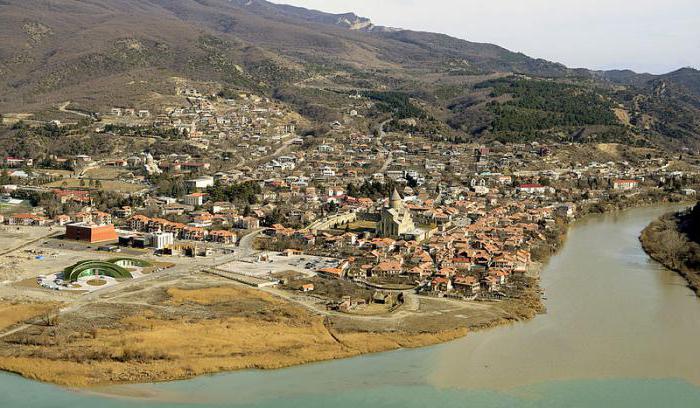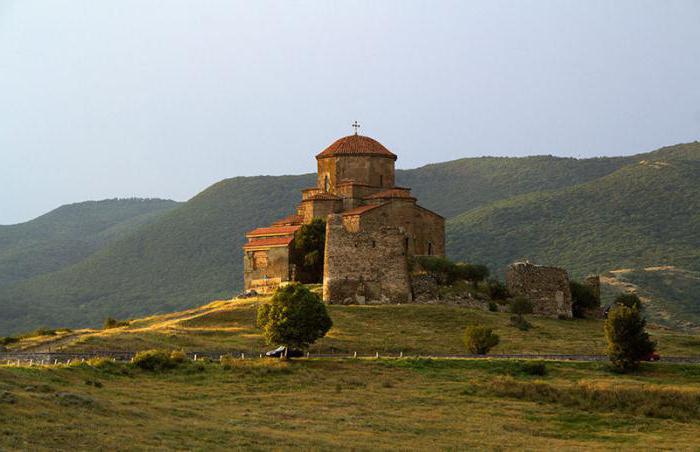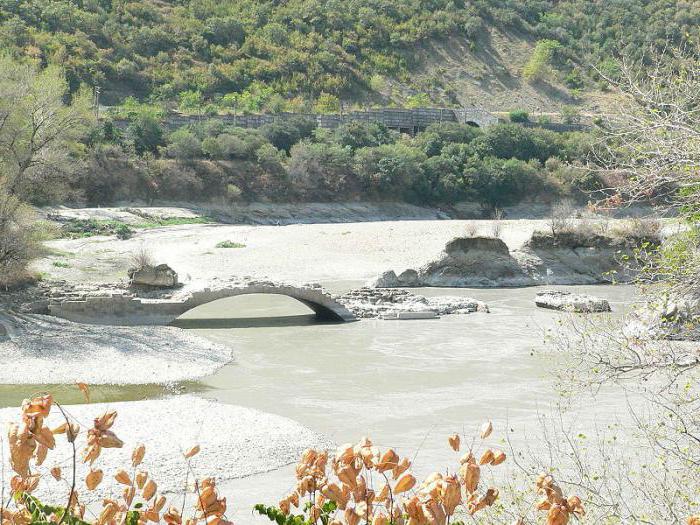What does an independent traveler traveling to such a picturesque country like Georgia need to know? Mtskheta, the sights of which will be described in this article, is an obligatory point on the route. After all, this city is the first capital of the country. And despite the fact that the title passed to Tbilisi, Mtskheta remains the heart of Georgia, its cultural and historical center. It is enough to walk along the ancient streets of the city to notice the traces of former greatness. Mtskheta is more than two thousand years old. And the Georgian government is investing a lot of money in the city to attract tourists to this ancient attraction. All historical monuments are restored here. But besides tourists, there are many pilgrims on the streets of Mtskheta. After all, it was from this city that the evangelization of Georgia began. And it happened back in the three hundred and twenty-seventh year of our era. What you should see in Mtskheta - you will learn from this article.

How to get there
First of all, you need to get to the modern capital of Georgia, Tbilisi. There are direct scheduled flights from Russia. They are offered by carrier companies such as S7 and Georgian Airlines. Travel time is two and a half hours. You can reduce the cost of a flight if you fly by connecting flights: with a change in Warsaw (LOT), Riga (Air Baltic), Istanbul (Turkish Airlines) or Kiev. If you arrive in Georgia by car, then the trip from Tbilisi to Mtskheta will take about a quarter of an hour. After all, the ancient and modern capitals are separated by only twenty kilometers. You could even say that Mtskheta has already become the remote outskirts of Tbilisi. Naturally, there is a bus service between the two cities. To get to Mtskheta, you need to come to the Didube metro station in Tbilisi. After leaving the subway, you should again dive into the underpass leading to the spontaneous market. Having passed the vegetable rows, you get to the same makeshift bus station. On its territory there is a box office. You should pay one lari for a ticket there - the driver does not take money. Convenient minibuses depart every fifteen minutes.
Climate and nature of Mtskheta
In addition to numerous historical and religious attractions, the ancient capital of Georgia is characterized by picturesque nature. The city stands at the place where Aragvi flows into Kourou. This river was described by Lermontov in the poem “Mtsyri”. But more on that later. The climate in Mtskheta is very mild. Winter is dry and not very cold (in contrast to the more mountainous areas). The temperature in January averages two degrees with a plus mark. And in the summer it’s not too hot. In July and August, the air warms up to quite comfortable twenty-five degrees. The best time for traveling to Mtskheta by experienced tourists and the locals themselves call the period from March to mid-November. The city is surrounded on all sides by low mountains, on the peaks of which ancient monasteries and fortresses are located.
History of Mtskheta
The first mention of the city in the annals dates back to the second half of the first millennium BC, when it became the capital of the ancient state of Iveria. But legends significantly increase the age of Mtskheta. According to legend, it was founded by the son of King Kartli. His name was Mcekhotos - he gave the name of the settlement. And from Kartli came the whole nation, who later founded a state called "Kartveli" (Georgia). Mtskheta, whose sights testify to the glorious past of the country, was a tidbit in the eyes of warlike neighbors from antiquity to the twenty-first century. The city tried to capture the Greeks, Persians, Romans, Turks and many others. For almost a thousand years, Mtskheta was the capital of a proud country, until King Vakhtang Gorgasali, who ruled in the fifth century, built Tbilisi and moved his residence there. But even then the city did not come to desolation. Mtskheta remained the religious capital. After all, the throne of the Catholicos, the head of the Christian Church of Georgia, was located there.

Georgia, Mtskheta: attractions (brief overview)
This city is called the Second Jerusalem. And for Georgians, this is a real religious shrine. Indeed, it was precisely in Mtskheta that the Christian saint Nino came with the good news of the Gospel. In addition, the main temple of the city still houses one of the most revered relics - the tunic of Jesus Christ, which under Calvarius was divided among themselves by Roman legionnaires. The glory of the Second Jerusalem and the residence of the Catholicos led to the appearance of numerous monasteries, which are located on the surrounding hills. Such an accumulation of historical and religious attractions can not be found anywhere else in Georgia. Therefore, the entire city of Mtskheta was taken under the protection of UNESCO and entered into its list as a world heritage of mankind. Must visit are Samtavro and Jvari monasteries, Svetitskhoveli Cathedral and the Bebritsikhe fortress. About thirty lari is an organized bus tour with a guide from Tbilisi.

Svetitskhoveli Cathedral. The history of the temple
It is the oldest Christian temple in Georgia. True, the building that you can admire today, was built in the eleventh century. But according to legend, already in the fourth century there was a small church. A beautiful legend is associated with her appearance. Having adopted Christianity, a certain girl, Sidonia, begged her brothers to bring from Jerusalem something that belonged to Jesus Christ himself. They listened to her prayers and returned home with a tunic, which was combined with the Savior before His crucifixion. As soon as Sidonia touched her clothes, she lost her breath. So she was buried, since the tunic could not be removed from the fingers of a dead girl. The first church was built over her grave. This is a unique place that Georgia is rightly proud of. Mtskheta, whose sights are numerous, is still famous as a place of storage of this Christian relic. Therefore, crowds of pilgrims flock to the city.
The legend of the creation of the cathedral
When the small church was destroyed during the next war, a huge cedar grew on the grave of Sidonia. The first Christian king of Georgia, Mirian, ordered the construction of a temple dedicated to the twelve apostles. Seven columns were cut from the cut cedar, which were supposed to support the vault. Six of them are set around the edges. But the seventh pillar hung in the air. Then the bishop Nino began to pray, and as a result, the column fell into place and pacified. Therefore, the temple is called Svetitskhoveli - “Life-giving Pillar”. After all, the precious world healed the patients who came to church for healing. This, of course, is a beautiful legend. The temple was built by the architect Arsukisdze. All excursions in Georgia visiting the cathedral tell that the architect’s teacher envied his skill, slandered the master, as a result of which his hand was cut off. Guides show the relief on the northern facade. He depicts a hand holding a square. But you need to find a unique mural with a flying saucer and a person looking out of the window. It is in the mural of the central miraculous pillar. Georgian kings - Heraclius II, Gorgasali, George XII and others are buried in the script of the temple. The cathedral hosts intronization ceremonies of the new Catholicos.
Samtavro Monastery
The monastery is located within the city of Mtskheta. The monastery was built by King Mirian on the site of an unexploited wooden church. The monastery was repeatedly destroyed and restored again. Under George I (the first half of the XI century), the monastery took its present form, although separate parts and the dome were created later, after the earthquakes of the XIII-XIV centuries. Altar gates also belong to the same period. Frescoes of the 16th-17th centuries have been preserved. The current Samtavro Convent contains a piece of the myrrh-streaming pillar, miraculous icons of the Iveron Mother of God and St. Nina, and other relics. The temple became the resting place of the first Christian king Mirian and his wife Nana. Also revered Georgian saint - Elder Gabriel is buried there.
Jvari Monastery
This is another shrine, which is famous for Mtskheta. Jvari is located outside the city, on a high hill. Getting out there, especially with children, it is worth taking a taxi - climbing the mountain is quite difficult. For twenty lari, the driver will take you to the observation deck, wait as long as you like and return to the city. It was about Jvari that Lermontov wrote in Mtsyri. At the foot of the cliff, the Aragvi River "intertwines in a sister's embrace" with Kura. The name Jvari is translated from Georgian as “Cross”. And the name of the monastery was not given by chance. On this rock, St. Nino erected a cross in honor of the adoption of Christianity by Georgia. And the church itself was built in the sixth century.
Bebriskiche Fortress
If you come to Georgia by car, be sure to visit this ancient monument. And if not, do not skimp on a taxi. This attraction of Mtskheta is located on its northern outskirts - also on the top of the hill. Looking at these picturesque romantic ruins, it is difficult to believe that once the castle of Bebritsikhe successfully defended the city from the invasion of enemies. It looks very small citadel. Most likely, her garrison was not numerous. Perhaps the fortress was impregnable due to its location and additional fortifications that have not survived to this day. In the annals of the citadel of Bebritsikhe mentioned since 1156. Within its walls, the king of Georgia, Demeter First, was killed. Unfortunately, in 2010 this attraction was seriously affected by a landslide.
Shio Mgvime Monastery
This monastery, along with Svetitskhoveli and Jvari, is considered the shrine of Georgia. Its uniqueness lies in the fact that the monastery is invisible, although it is not hidden. It’s just that his buildings merge so much with the yellowish color of the rocky ledges that they appear only when the traveler approaches the monastery at a close distance. Many excursions in Georgia come to this oldest sacred complex in Mtskheta. The monastery got its name from Simeon Mgvimsky, who built the church here in the sixth century. It has been preserved almost in its original form. The low building with a two-tiered dome, which is crowned by a pedestal with a gabled roof, has no analogues not only in Georgia but also in the world. The monastery is interesting not only for the church. The cells of the ancient monks cut through right in the rocks. The acting and still male cave monastery preserves the miraculous icon of the healer Panteleimon, which attracts many pilgrims.
Natural attractions of Mtskheta
In the vicinity of the city is Kazbegi National Park. This is not only a great opportunity to get acquainted with the picturesque nature of Georgia. After all, the gorge in the Terek valley has long been the most important strategic passage from Transcaucasia to the north. Sheer cliffs crowned with medieval castles. Kazbegi is the third highest mountain. According to legend, Prometheus was chained here.